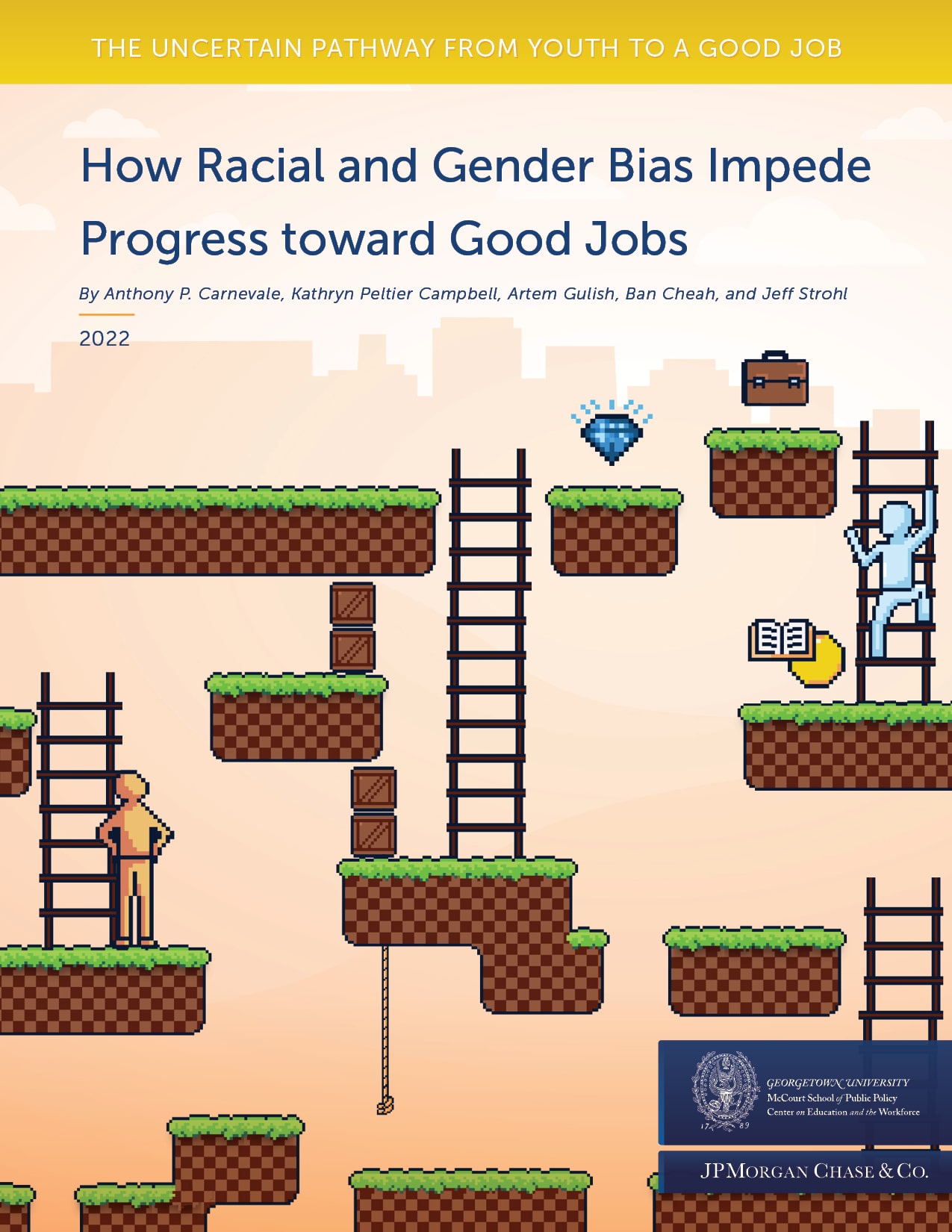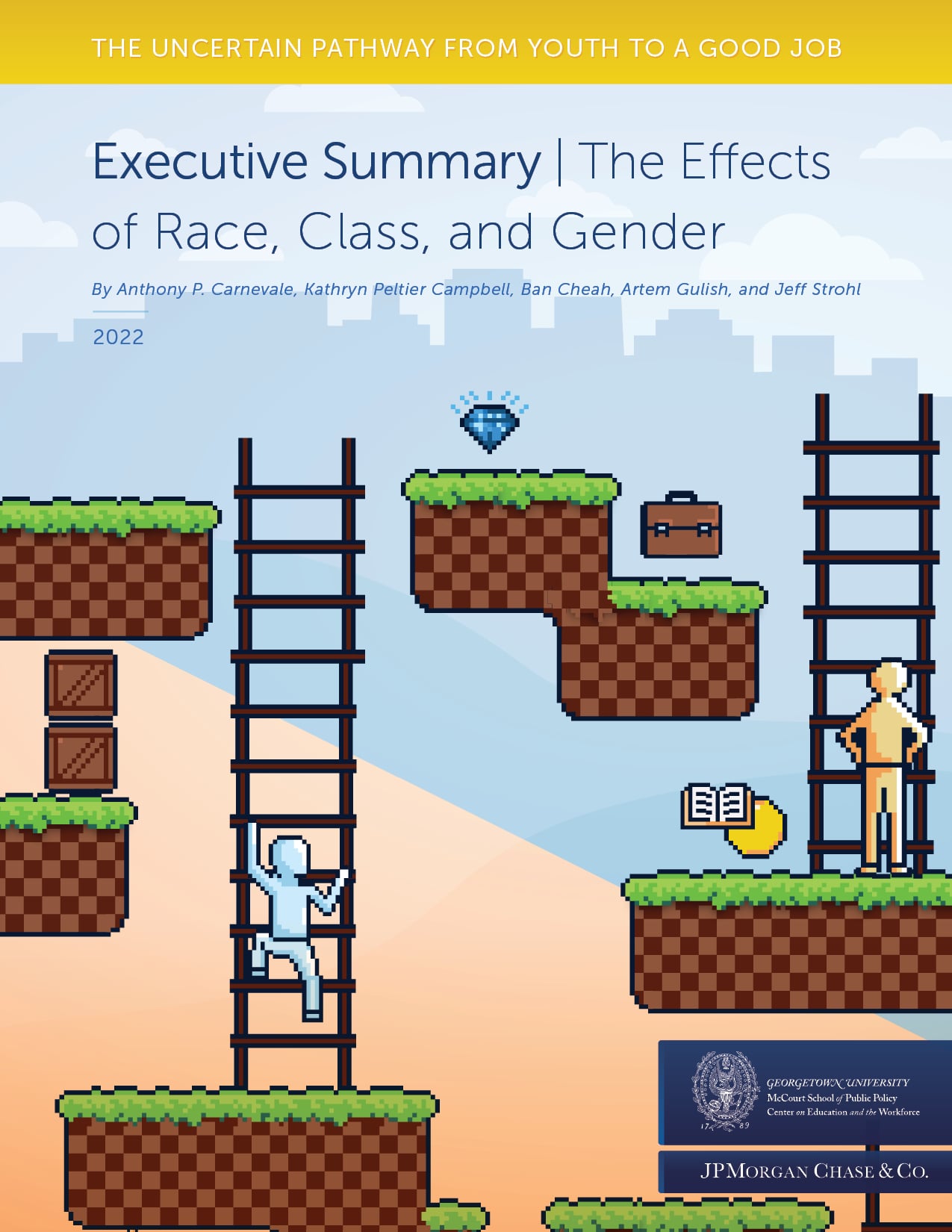The Uncertain Pathway from Youth to a Good Job
Summary
Over the past several decades, the pathway to a good job has become longer and more challenging for young adults to navigate. Today, most young workers do not attain a good job until their early 30s, and only young workers with a bachelor’s degree or higher are consistently more likely than those in the previous generation to have a good job before age 30. Further, the disparities in good jobs by race/ethnicity and gender persist.
To secure a good job, young adults need more education and high-quality work experience than was necessary for previous generations. But three hurdles stand in their way:
- the rising cost of postsecondary education,
- limited access to high-quality work-based learning, and
- the absence of comprehensive counseling and career navigation services.
What Is a Good Job?
A good job pays at least $35,000 per year and $57,000 at the median for young workers (ages 25 to 35) nationwide, with adjustments based on cost-of-living differences among states.

It Takes Longer for Young Adults to Attain a Good Job than in the Past
Most young adults need more time today than young adults did in the past to acquire the additional education and job experience that they need to land a good job. However, by age 30, a greater share of today’s young adults have a good job compared to the previous generation.
Source: Georgetown University Center on Education and the Workforce analysis of data from the US Census Bureau and Bureau of Labor Statistics, Current Population Survey (CPS), 1972–86, 2007–20.
Note: Data are for 25-to-35-year-olds in the labor force. Young workers with good jobs are those with earnings of $35,000 or more nationwide. We adjusted the good jobs threshold based on cost-of-living differences among states using 2018–19 data from the Massachusetts Institute of Technology (MIT), “Living Wage Calculator,” 2020.
Postsecondary Education and Training Have Become Crucial in Gaining Access to Good Jobs
Young adults generally need at least some postsecondary education and work experience to have a decent chance of getting a good job. Among older millennials in the labor force, 80% of those with a bachelor’s degree or higher had a good job at age 35, compared with 56% of those with some college or an associate’s degree, 42% of those with only a high school diploma, and 26% of those with less than a high school diploma.

Source: Georgetown University Center on Education and the Workforce analysis of data from the US Census Bureau and Bureau of Labor Statistics, Current Population Survey (CPS), 1972–86, 2007–20.
Note: Data are for 25-to-35-year-olds in the labor force. Young workers with good jobs are those with earnings of $35,000 or more nationwide. We adjusted the good jobs threshold based on cost-of-living differences among states using 2018–19 data from the Massachusetts Institute of Technology (MIT), “Living Wage Calculator,” 2020.

Daunting Inequality Persists in Both Education and Labor Markets
Persistent racial/ethnic equity gaps in educational attainment lay the groundwork for equity gaps in the likelihood of attaining a good job. Gender gaps also persist despite widespread generational changes in women’s educational attainment. And when race and gender disparities are combined, the gaps in the likelihood of having a good job are even more striking: at every education level, young women are less likely to have a good job than young men within the same racial/ethnic group. These disparities reflect labor market discrimination among equally educated workers.
Source: Georgetown University Center on Education and the Workforce analysis of data from the US Census Bureau, American Community Survey (ACS), 2009–19 (pooled).
Note: Data are for young adults in the labor force who were born from 1981 to 1985 and who ranged in age from 25 to 35 during the survey years. Young workers with good jobs are those with earnings of $35,000 or more nationwide. We adjusted the good jobs threshold based on cost-of-living differences among states using 2018–19 data from the Massachusetts Institute of Technology (MIT), “Living Wage Calculator,” 2020.
Other factors also contribute to young workers’ odds of obtaining a good job, including their college major, occupation, and whether they work full time—as well as how much discrimination they encounter in the labor market. Discrimination in the labor market and the education and training system contributes to substantial racial/ethnic and gender disparities in the likelihood of having a good job.
The Elongated Transition to Good Jobs Has Long-Term Financial Consequences
The slow journey to good jobs has consequences for young people’s economic well-being. As a result of the longer transition to good jobs and higher educational debt, young adults today accumulate less wealth than the previous generation, with disparities in wealth by race/ethnicity and gender. In fact, young Black/African American women have less than $1,000 median net worth at all levels of education.

Source: Georgetown University Center on Education and the Workforce analysis of data from the US Census Bureau, Survey of Income and Program Participation (SIPP), 2014 (wave 1) and 2018 (wave 1).
Note: The data are inflation-adjusted to 2019 dollars. In this section of the report, we have excluded data on the wealth of American Indian/Alaska Native and Native Hawaiian/Pacific Islander young adults due to small sample sizes in many of our data sets.
Seven Recommendations for Comprehensive Reform
- Embrace our country’s diversity and reject racial/ethnic and gender injustice, including through investments in culturally responsive teaching and counseling.
- Apply an equity lens to all policy and programmatic reforms by measuring inequality and crafting policies and programs designed to address it.
- Provide targeted, wraparound educational and social supports to young people from cradle to career, including universal pre-kindergarten and equitably funded public schools.
- Invest in programs that treat education and labor markets as a single system extending from early childhood to the first good job, including those with strong employer involvement.
- Help young people—especially those who are most marginalized by the education system—pursue and attain their education and career goals simultaneously using career exposure and work-based learning.
- Create a transparent, data-based education and career navigation system that is accountable for making outcomes more effective and equitable.
- Make college more affordable and more convenient by investing in free college, incremental credentialing, community college baccalaureate programs, and better transfer pathways.



